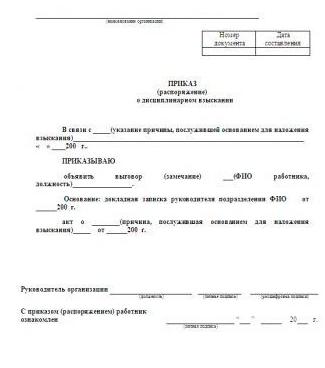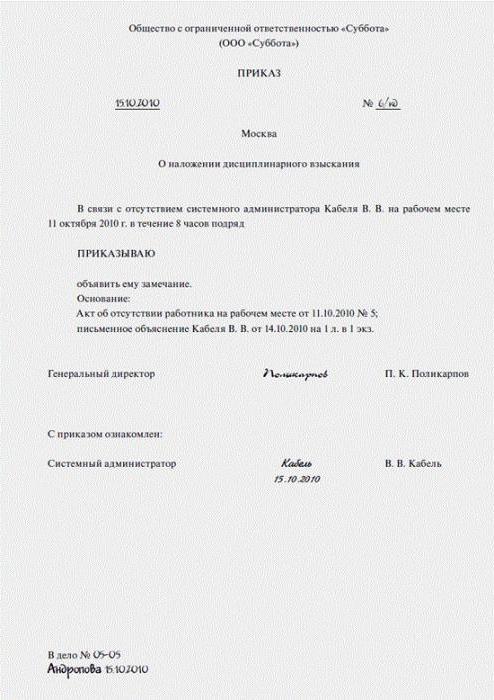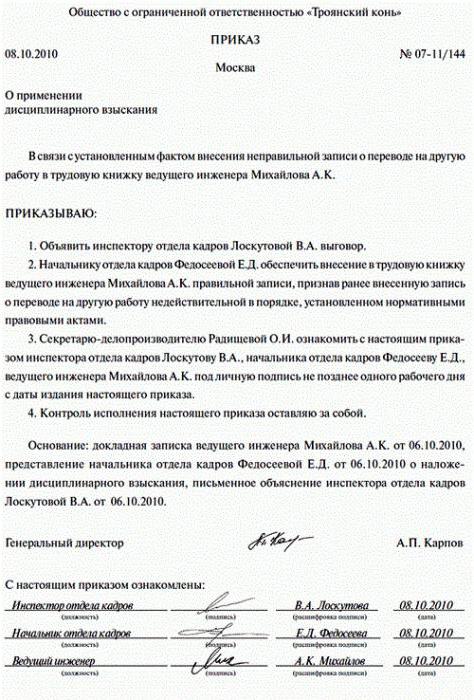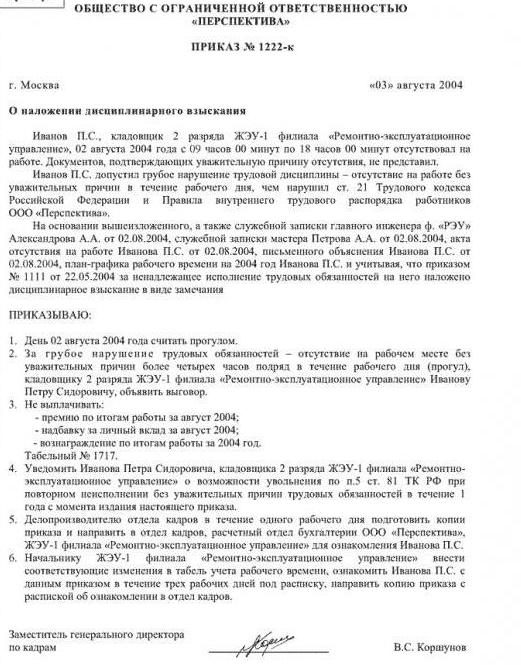Each personnel officer should be able at the right time to develop a “Disciplinary Order”. The sample does not have to be in the form of a blank. You just need to know how to correctly reflect what the law says in such a document.
Punishment in accordance with the law
People often, being at the workplace, commit various misconduct, for which they must be deservedly punished. Separately, it is worth paying attention to violations of a disciplinary nature. They are mainly related to the fact that the employee does not fulfill the duties assigned to him or does it inappropriately. For such violations, the Labor Code of Russia in article 192 provides for the imposition of a certain type of punishment on the perpetrator:
- rebuke,
- comment,
- dismissal.
The choice depends on the seriousness of the misconduct and management decision. As a result, a “Disciplinary Order” is drawn up, a sample of which meets all the necessary requirements.

Previously, the employer must study all the circumstances of the case. To do this, he must request from the guilty employee an explanation of the fact of the committed misconduct, set out in writing. It, together with other documents, will be the basis for issuing a “Disciplinary Order”. A sample explanation is not needed in this case. It is compiled arbitrarily. Here, the employee must state all the circumstances and reasons that prompted him to commit this misconduct. Having studied this document, the head makes the final decision, which will contain the “Order on the disciplinary sanction”. The sample drafting and the types of possible punishments will be prompted to him by a personnel officer.
Lightweight Punishment
Disciplinary responsibility can be of two types: general and special. Both of these cases are addressed in some detail in the Labor Code. A special case of general liability is considered a comment by management. This punishment can be considered minimal. Despite the fact that under the law all forms of punishment are equal to each other, a remark, unlike the others, as a rule, does not lead to other consequences. For example, a reprimand under many collective agreements threatens the violator with the deprivation of bonus payments for a certain period. This usually does not apply to the remark. This punishment is more of an educational and edifying character. But the “Order on imposing a disciplinary sanction” itself in the form of a comment is drawn up according to general rules.

It can conditionally be divided into three parts:
- Description. Here, the conditions and reasons for the misconduct are comprehensively specified.
- Motivation contains documents that are the basis for choosing a punishment.
- The resolution includes all the data about the employee and the chosen measure of influence on him. Moreover, the wording should repeat word for word what is said in the Labor Code.
The order is signed by the head and is given for familiarization to the offending employee.
Justification for severity
Any action can be explained. But this does not exclude well-deserved punishment, the choice of which must take into account:
- circumstances of the case
- employee guilt
- the severity of his misconduct,
- previous services to the team.
Only after such a thorough investigation can you be sure that a fair decision will be made.If the misconduct turned out to be serious enough, then the “Disciplinary sanction” is already issued in the form of a reprimand.

Such a penalty is considered more stringent than a simple remark. In addition, it may be followed by deprivation of a bonus or other types of promotion. But this is not at all necessary. If an employee meets the required criteria, then the manager does not have the right to depress him, unless this is provided for in a separate regulation on the enterprise. The order itself, as in the previous version, consists of three main parts and is developed for all office rules:
- First, the details of the document and its name are indicated.
- Then comes a brief description of the event.
- Next, after the word “I order”, a verdict is issued with a detailed transcript of the punishment.
- Following is a list of documents on the basis of which a decision was made.
- It ends with all signatures (manager, employee and other responsible persons)
Worker's punishment for absenteeism
One of the most common types of violations at work has always been considered truancy. He was punished in the most severe way. The most popular punishment for such misconduct is dismissal. But here everything should be legal from beginning to end. First of all, the fact of absenteeism should correspond to one of the cases listed in Article 81 of the Labor Code of the Russian Federation, and be fixed in a separate act. It must be remembered that absenteeism by law has two prerequisites:
- the employee must be absent from work longer than 4 hours in a row,
- not have good reason to explain such an action.
Of course, a ten minute delay does not apply to such a violation. Usually the question is raised on a more serious occasion. It was then that the "Order on the imposition of a disciplinary sanction" for absenteeism was created. The sample is a standard punishment document.

In this case, the most important thing is to comply with the rule of law. To write a draft of such an order, it is necessary to have an appropriate package of documents (explanatory officer, certificate of absence from the workplace, memo direct manager, letter of call and others). It must be published no later than a month from the date of absenteeism. Otherwise, any employee can seek help from specialists who, on the basis of the law, will cancel an unfair decision.






